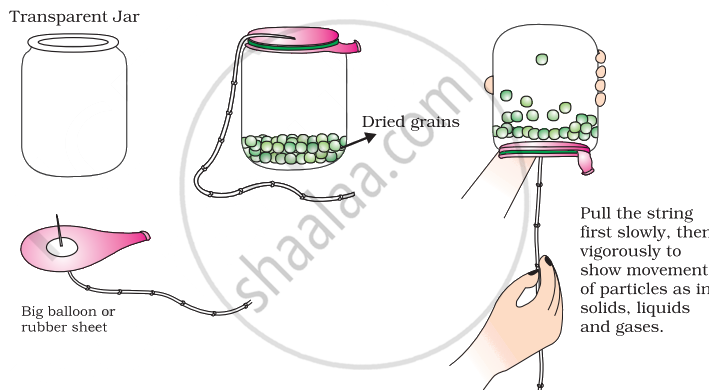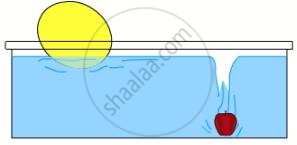Advertisements
Advertisements
प्रश्न
Prepare a model to demonstrate movement of particles in solids, liquids and gases.
For making this model you will need
- A transparent jar
- A big rubber balloon or piece of stretchable rubber sheet
- A string
- Few chickpeas or black gram or dry green peas.
How to make?
- Put the seeds in the jar.
- Sew the string to the centre of the rubber sheet and put some tape to keep it tied securely.
- Stretch and tie the rubber sheet on the mouth of the jar.
- Your model is ready. Now run your fingers up and down the string by first tugging at it slowly and then rapidly.

उत्तर
Materials Required:
- A transparent jar
- A big rubber balloon or piece of stretchable rubber sheet
- A string
- Few chickpeas, black gram, or dry green peas
Steps to Make the Model:
-
Prepare the Jar:
- Take a transparent jar and put the dried seeds (chickpeas, black gram, or dry green peas) into the jar. These seeds will represent the particles.
-
Attach the Rubber Sheet:
- Sew a string to the centre of the rubber balloon or rubber sheet.
- Secure the string tightly using some tape to ensure it stays attached.
- Stretch the rubber sheet over the mouth of the jar and tie it securely. This setup allows the rubber sheet to simulate the movement when the string is pulled.
-
Demonstrating Particle Movement:
- Your model is now ready.
- Gently pull the string attached to the rubber sheet and observe the movement of the seeds inside the jar.
- Start by tugging the string slowly to demonstrate the movement of particles in solids, where they move slightly.
- Then, pull the string more vigorously to demonstrate the movement of particles in liquids and gases, where they move more freely and rapidly.
This model effectively shows how particles in solids, liquids, and gases behave differently depending on the energy (represented by the speed of string pulling) applied to them.
संबंधित प्रश्न
For any substance, why does the temperature remain constant during the change of state?
Mention a change which is always desirable.
State whether the following is physical or chemical changes.
heating of water —
Ripening of fruits is a desirable change.
Is there any change in temperature during the change of phase?
Fill in the following blank with suitable words :
When steam condenses to form water, heat is .......................
On converting 25°C, 38°C and 66°C to Kelvin scale, the correct sequence of temperatures will be :
Differentiate between: Melting and boiling
Why does this happen?
What you see in the picture.

Photosynthesis is a natural process by which green plants manufacture food in the presence of sunlight.
Are any new products formed during the above process.
